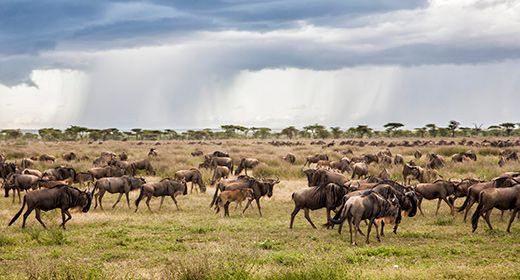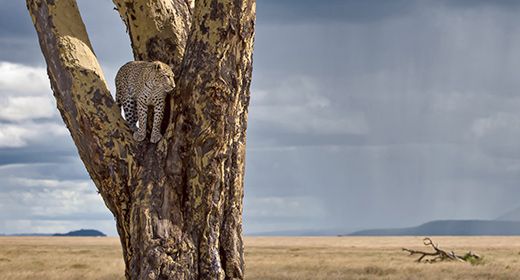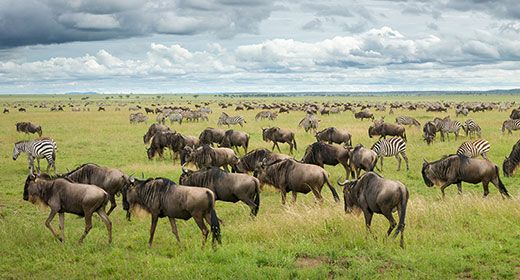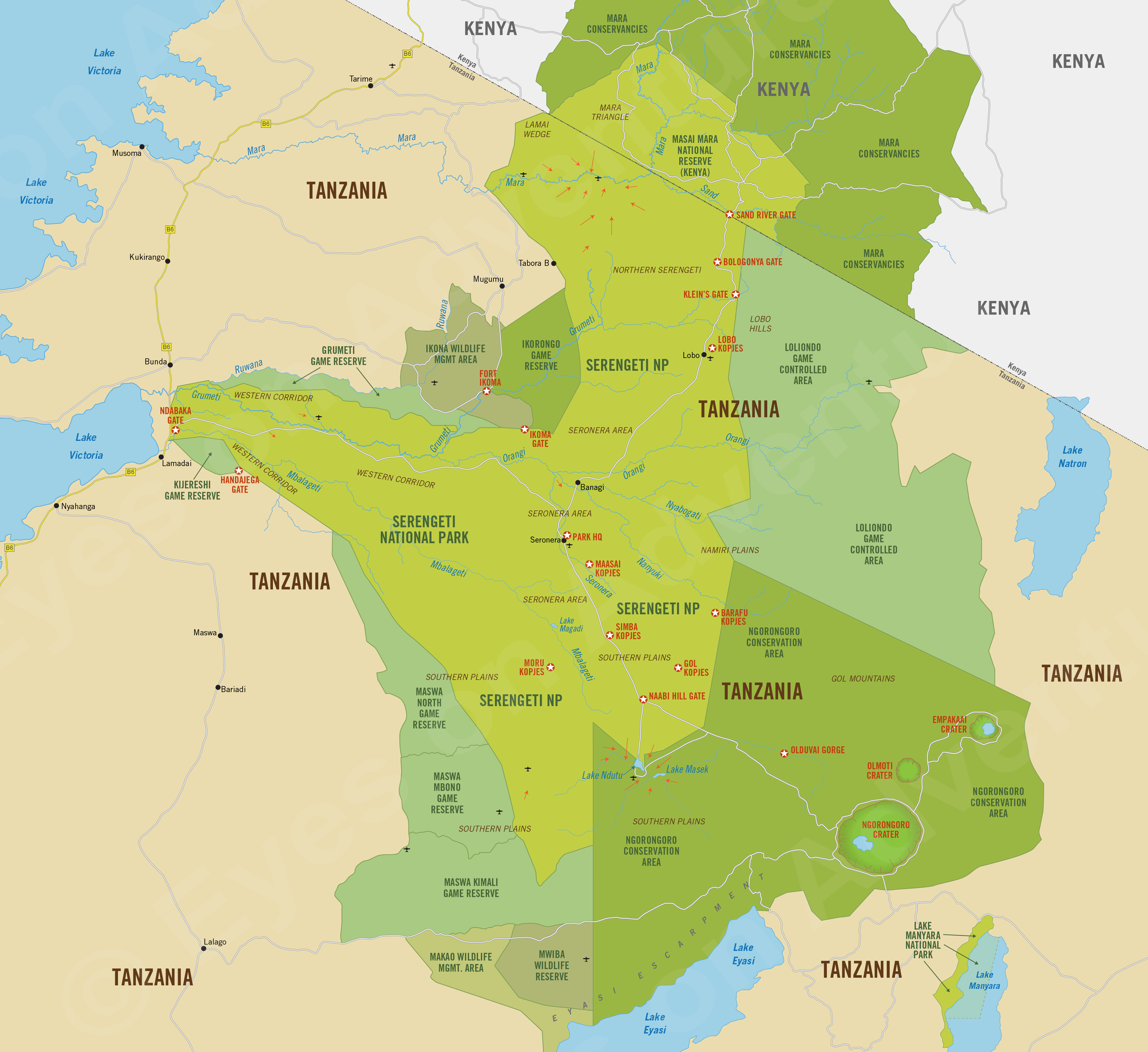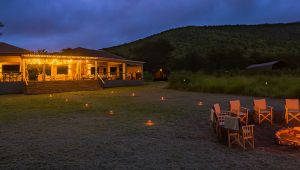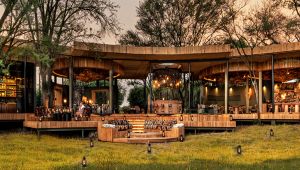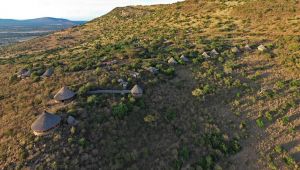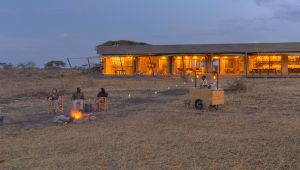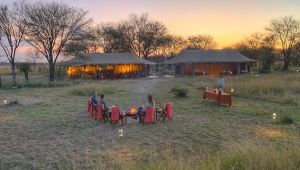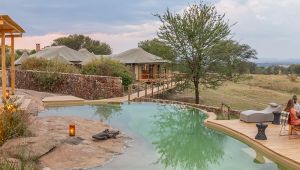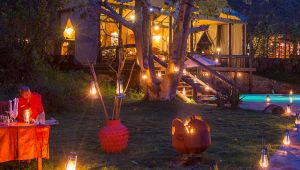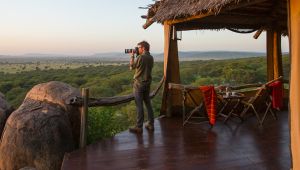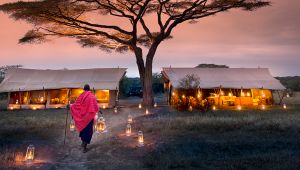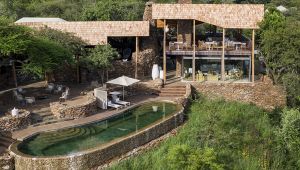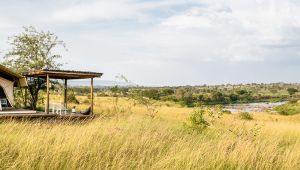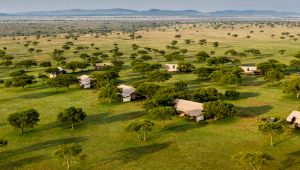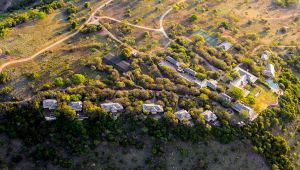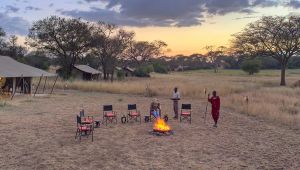Serengeti
(incl. Serengeti NP, Grumeti, Ikorongo, Maswa & Loliondo Reserves)
Region Links: Great Migration, Kilimanjaro & Arusha, Ngorongoro & Manyara, Serengeti, Southern Tanzania, Tarangire, Western Tanzania, Zanzibar
Highlights
- Annual Great Migration of over two million animals
- Superb predator viewing, especially of the big cats
- The greatest quantity of wildlife in Africa
- Experience the Maasai tribal culture
- Surrounding game reserves like Grumeti and Ngorongoro also offer safaris
- Wide range of safari accommodation including seasonal migration camps
EOA Recommends: Dunia Camp, Namiri Plains, Sayari Camp, Serian Serengeti North (Seasonal), Singita Faru Faru Lodge, Singita Sasakwa Lodge
The Serengeti is one of the world's top wildlife destinations and home to the spectacular Great Migration. Big herds and lots of predators make a Serengeti safari one of Africa's legendary experiences.
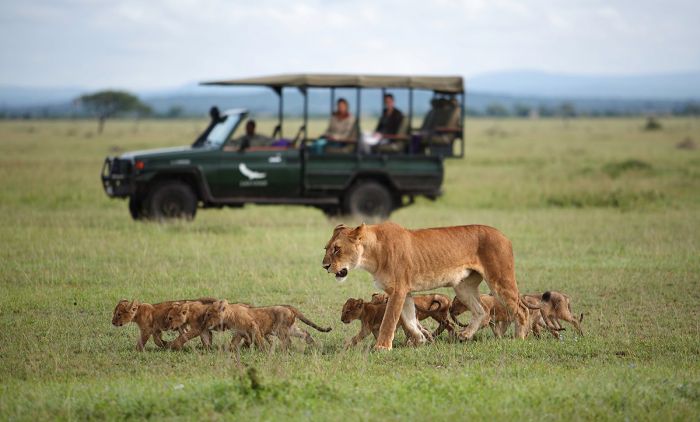
A lioness and her cubs seen on a safari in the Serengeti (photo courtesy of AndBeyond).
The Serengeti-Mara ecosystem, which includes the adjoining Masai Mara Game Reserve across the border in Kenya, supports so much wildlife that even all the hype does not do it justice. It must be experienced in person.
Besides wildlife, the Serengeti also offers a great cultural experience. The Maasai people have lived and grazed their cattle in Northern Tanzania for centuries and they are encountered on every trip to the region. The name 'serengit', means "endless plains" in the Maa language.
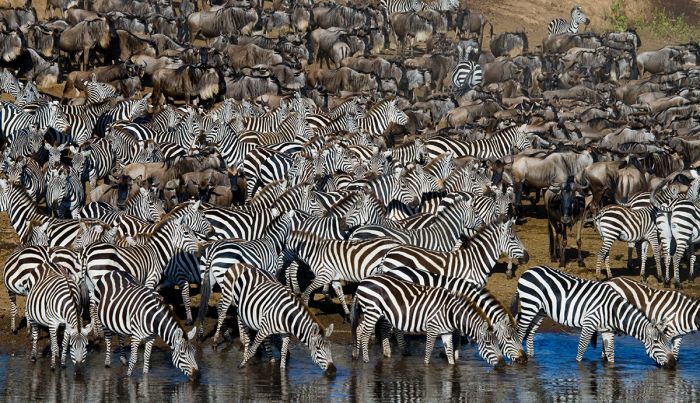
Big herd of zebras and wildebeests in the Serengeti.
Vast grasslands, dotted with iconic acacia trees make up a large portion of the land, making it an ideal habitat for its denizens of grazing herbivores, like zebras, wildebeests, buffalo, and gazelles. The big cats and other predators are also here in healthy numbers, including lions, leopards, and spotted hyenas. Cheetahs are especially well suited to the wide open plains and this is the best place in the world to see them.
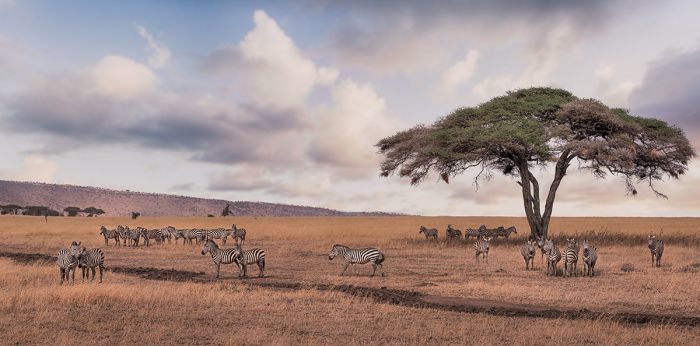
Zebras on the Serengeti plains in Tanzania.
One of the world's great wildlife phenomenons is the Great Migration of wildebeests and zebras. The herds follow a 500-mile (800-km) clockwise route covering the Serengeti and Masai Mara grasslands that takes one year to complete. Between two and three million animals, mostly wildebeests, are constantly moving in search of fresh grasses, crossing crocodile-filled rivers and eluding predators along the way. It is the largest migration of mammals on earth.
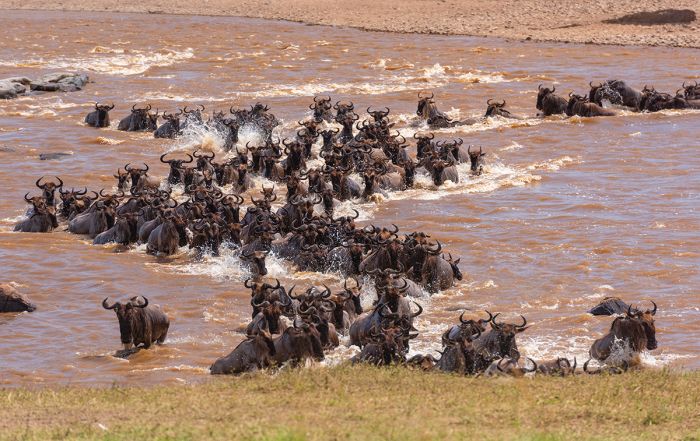
Wildebeests crossing the Mara River during the Great Migration in the Serengeti.
Many travelers return year after year to the Serengeti to experience its abundant wildlife, wide-open plains, dramatic rivers, big cats, and superb safari camps. This is a destination that should be at or near the top of your bucket list!
Read More...
Accommodation, Balloon Safaris, Great Migration, Grumeti, History, Ikona, Ikorongo, Kopjes, Lamai Wedge, Loliondo, Maswa, Ndutu, Northern Serengeti, Serengeti-Mara, Serengeti National Park, Seronera, Southern Plains, Western Corridor, Wildlife
History
The Maasai people first migrated south towards Tanzania from the area north of Lake Turkana in northwest Kenya in the 1400s. The first Maasai arrived into the Serengeti lands in the 1600s, forcibly removing or assimilating with other ethnic tribes already in the area. By the mid 1800s, the Maasai tribe controlled most of the Great Rift Valley. The Germans colonized much of Tanzania beginning in the late 1800s, but the Maasai's fierceness kept colonization in the wild northern lands at bay until the early 1900s.
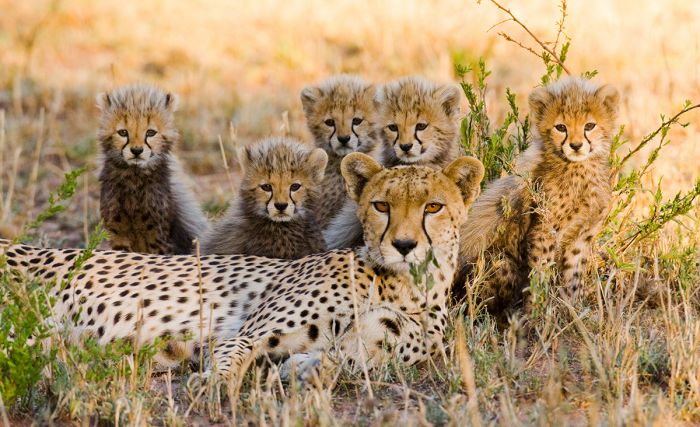
The Serengeti is well-known for its resident cheetahs.
After World War I, Britain was awarded control of what was then German East Africa (present-day Tanzania). Big game hunters soon discovered the wildlife-rich lands of the Serengeti and the wild animals, especially lions, were killed in huge numbers. In order to protect the vanishing wildlife, the British declared a small game reserve of about 800 acres in 1921. This tiny reserve became the foundation for the Serengeti.
Serengeti National Park was officially proclaimed in 1951, including all of the present-day park, as well as the current Ngorongoro Conservation Area (NCA).
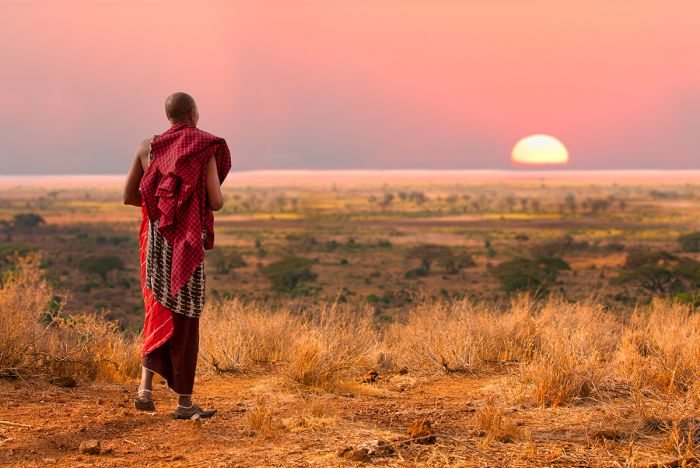
Massai man in the Serengeti.
A 1959, a German documentary film called "Serengeti Shall Not Die" brought world acclaim to the region and its wildlife. Subsequently, the British began forcibly evicting the Maasai from the Serengeti Park and moving them east to the Loliondo region. Widespread protests ensued and ultimately a compromise was reached whereby the NCA was split off from the park, giving the Maasai a place to live. The Maasai are no longer allowed to live nor graze their cattle in the Serengeti National Park. Controversy over these evictions continues even today, with various land claims under dispute.
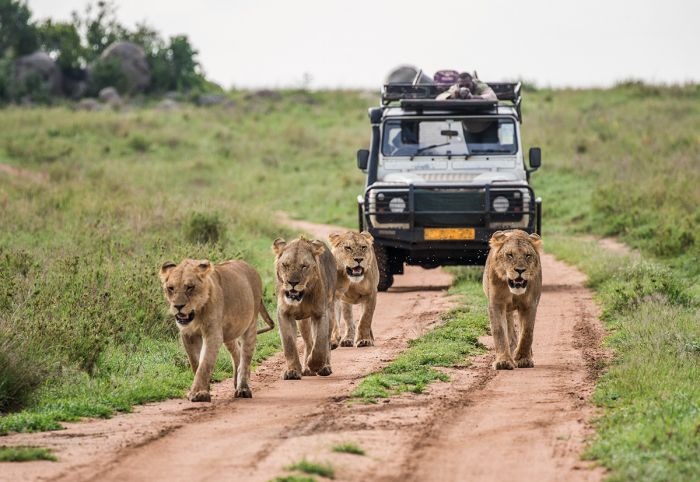
Photographing lions in the Serengeti.
Serengeti-Mara Ecosystem
The combined area of Tanzania's Greater Serengeti (which includes its adjoining conservation areas and privately managed reserves) and Kenya's Greater Masai Mara (which includes its adjoining private conservancies) covers around 15 000 sq miles (39 000 sq kms).
This Greater Serengeti-Masai Mara ecosystem straddles the Tanzania/Kenya border and is arguably the greatest wildlife-viewing destination in the world. The well-known spectacle that is the Great Migration entails over two million large mammals trekking through the grasslands of this rich ecosystem.
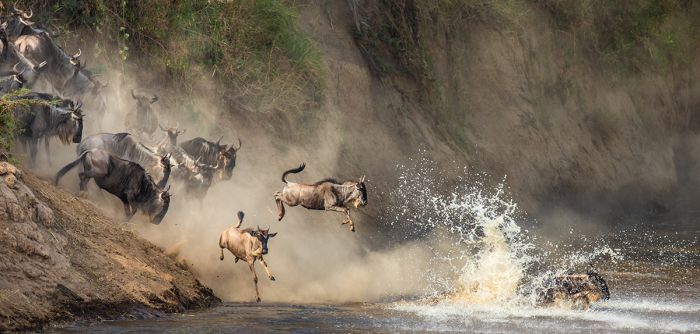
Wildebeests leaping into the Mara River during the Great Migration in Tanzania's Serengeti National Park.
The Great Migration
Perhaps the greatest spectacle in the animal kingdom is known as 'The Great Migration', which occurs on the Serengeti-Masai Mara ecosystem and consists of roughly two million wildebeests and zebras, on an endless trek in search of fresh grazing. The cycle takes one year to complete, moving in a circular, clockwise direction as the herds migrate thru the Serengeti and Masai Mara grasslands.
The massive aggregation of herbivores spend around nine months in Tanzania's Serengeti (from mid-October thru mid-July) and the other three months in Kenya's Masai Mara. The annual calving season occurs in the Serengeti in late January and early February.
Besides the resident predators like lions, spotted hyenas, and leopards that a constant threat to the herds, the Mara and Grumeti Rivers are dangerous obstacles that that are home to large numbers of Nile crocodiles that wait for months to feed on the zebras and wildebeests. Many in the herds perish during the chaotic river crossings, many from drowning and others falling prey to the crocodiles.
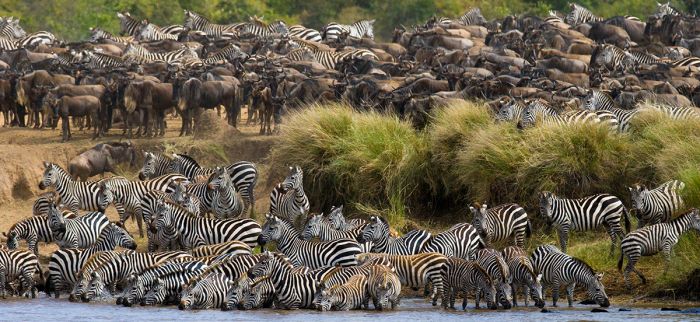
Zebras and blue wildebeests gather at the Mara River in Tanzania.
Some tourists come to the Serengeti in hopes of timing their visit to witness the dramatic river crossing, which is surely something to witness. The best time for seeing the dramatic Mara River crossings by the wildebeest and zebras is when the herds are leaving Tanzania and moving north into Kenya, which is typically in July and sometimes in August.
The first week or so of the river crossings means that the crocs are still very hungry and this is when the predation happens. Needless to say, this is not for everyone, as the carnage can be a bit overwhelming. Staying at a safari camp along the Mara River in the northern section of the national parks means you are close to the most-used crossing points.
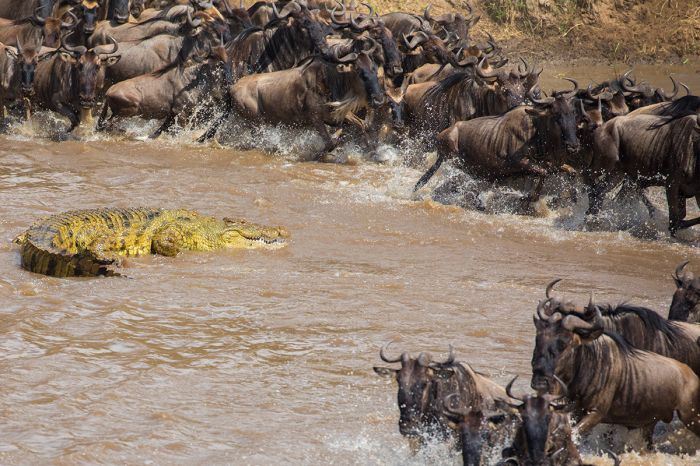
Nile crocodiles pose a serious threat to wildebeests and zebras whenever they cross the Mara River.
Besides the migrating herds, the Serengeti offers superb wildlife viewing throughout the, even during the months when the migration has moved north into Kenya. It is only the wildebeests and zebras that make the migratory trek, while the other animals are either resident, such as cheetah, lion, leopard, spotted hyena, giraffe, and numerous antelopes and gazelles, or semi-nomadic like elephants. Regardless of the time of year, wildlife is always abundant in the Serengeti.
The Serengeti is a massive national park, so it is a good plan to stay at two or perhaps three different safari camps spread out in the various sections of the park. The various park sectors are discussed below.
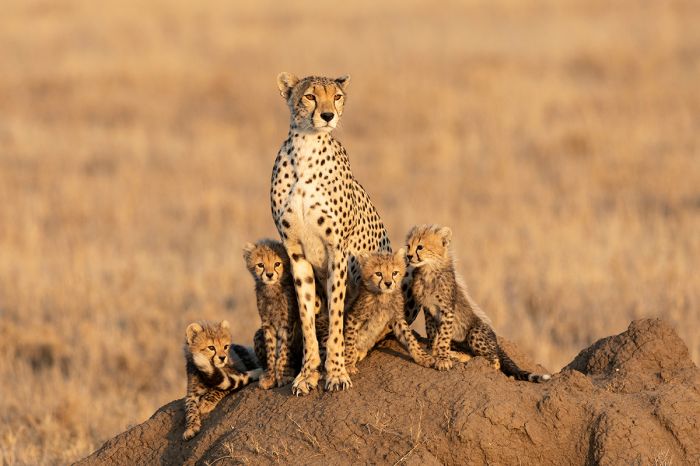
The Serengeti is one of the best places in Africa to see cheetah.
Serengeti National Park
Tanzania's first national park (declared in 1951), Serengeti NP covers 5 700 square miles (14 763 sq kms) and is one of the world's richest wildlife ecosystems. Together with the adjoining Ngorongoro Conservation Area (NCA), they were declared a UNESCO Biosphere Reserve in 1981. The region attracts between 150 000 - 200 000 visitors each year, mainly for eco-friendly tourism, but some hunting and poaching do exist in areas outside the national park.
Serengeti National Park can be described as having four main sectors: the Southern Plains and Kopjes, Seronera in the middle, the Western Corridor, and the Northern Serengeti.
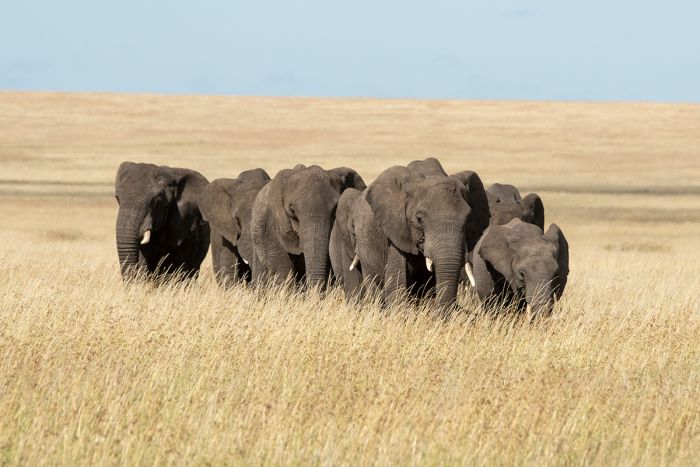
Elephants crossing Serengeti plains.
Southern Plains: Much of the southern half of the park is open, semi-arid grasslands and they form the main base of the park's ecosystem. When the migration arrives to the plains between January and April, the entire landscape is full of an almost unimaginable number of wildebeest, zebras, and gazelles, all grazing on the rich grass that grows here.
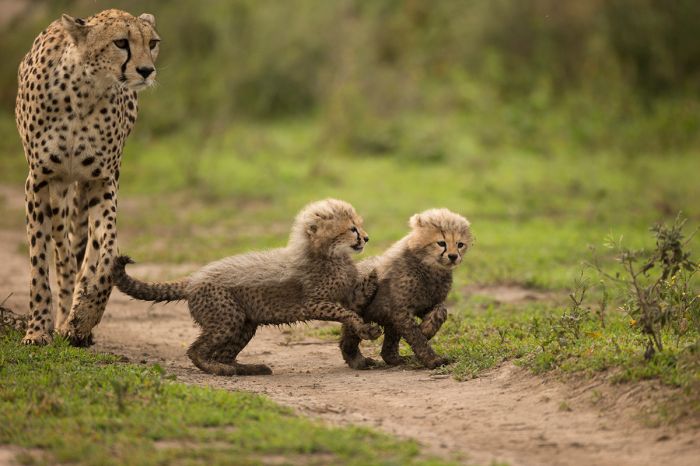
Cheetah and cubs in the Serengeti's Southern Plains sector.
The richness of these plains is the result of volcanic ash that was deposited here by long-ago eruptions of the volcanoes in the Ngorongoro Highlands to the east. The ash contains minerals that are important supplements to the nutrition of herbivores, especially lactating females, which is why most of the wildebeests give birth on these plains during January and February.
When the migration moves on to the north, the plains are still home to plentiful year-round wildlife, including lion, cheetah, and large numbers of spotted hyenas, which hunt a wide diversity of prey species, such as topi, red hartebeest, Grant's gazelle, Thomson's gazelle, warthog, and more. The Southern Plains extend past the national park's boundaries into the NCA and Maswa Game Reserves.
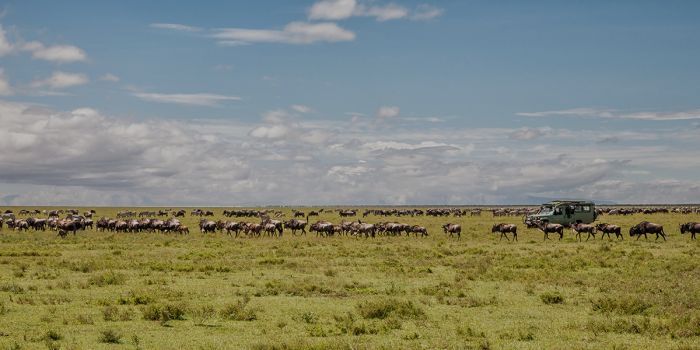
The southern plains around Ndutu in March (note the recently born calves).
Ndutu: Lake Ndutu is a shallow, alkaline lake located in the far Southern Plains on the border with the Ngorongoro Conservation Area (NCA). The area around the lake and around nearby Lake Masek is the site of several seasonal migration camps. Some camps in the Ndutu area are located in the NCA and some are inside the Serengeti NP.
These camps are located here from around December until April to take full advantage of the wildebeest and zebra migration, that peaks here during those months. Some camps in Ndutu offer day trips to the Ngorongoro Crater, located 35 miles (56 km) southeast.
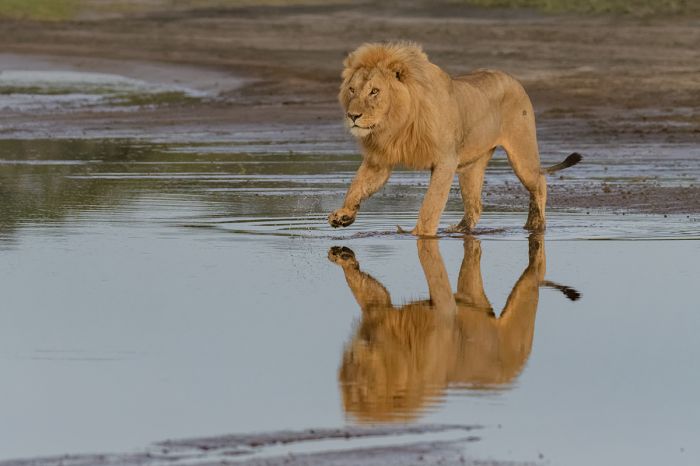
A male lion walks along Lake Ndutu in the southern Serengeti.
Kopjes: The southern plains are interrupted in several isolated places by semi-eroded granite or gneiss inselbergs, called "kopjes". These kopjes are like islands in a sea of grass. The granite was pushed up by volcanic pressure millions of years ago and has been eroded by wind and rain over the millennia. The rock forms collect rain water, creating temporary water sources for animals during and after the rains. Lions are often found sunning atop the various kopjes in the park, as they provide a good vantage point and a place to keeps cubs safe when they are very young.
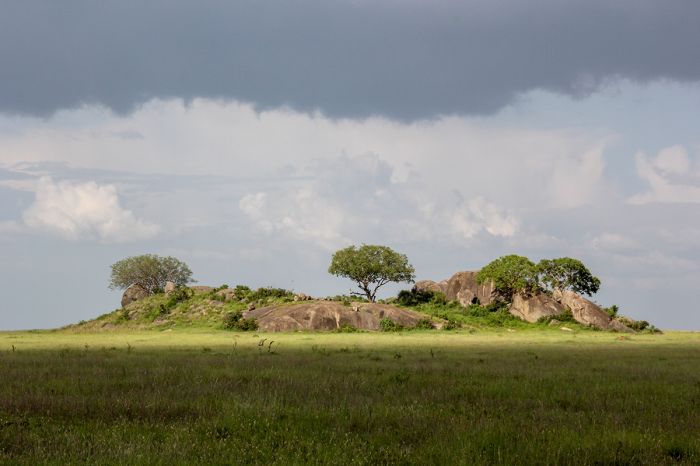
One of the Serengeti's kopjes.
Moru Kopjes, located 20 miles (32 kms) south of Seronera, contain a rock shelter historically used by Maasai warriors before they tribe was evicted from the park. Inside the shelter are some interesting rock paintings showing Maasai shields, humans, and various animals.
Note that there are also kopjes in Seronera and further north around Lobo.
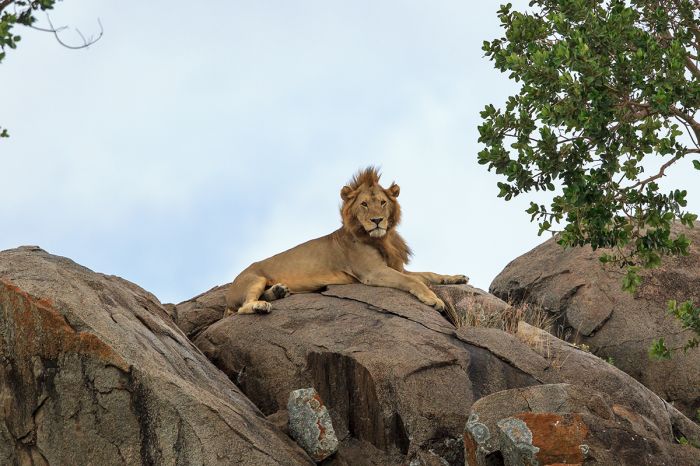
A beautiful male lion lounging on a kopje.
Seronera: The central sector of the Serengeti is called Seronera. Tributaries of the Grumeti River flow through Seronera, providing ideal habitat for leopards, which are here in good numbers. Between the rivers are wooded valleys and savanna grasslands, which attract all of the Serengeti's wildlife, including well-known lion prides, leopard, spotted hyena, jackal, serval, topi, impala, hartebeest, buffalo, giraffe, Grant's gazelle, Thomson's gazelle, waterbuck, reedbuck, dik-dik, warthog, and others.
Like the Southern Plains, Seronera has great wildlife throughout the year, but animal densities are highest during the rain season (November to May), when the fertile soils produce rich grasses for the migrating herds of wildebeest and zebra. The wildebeests use the southern plains for birthing their young in January and February and begin moving slowly north, usually reaching Seronera sometime in April.
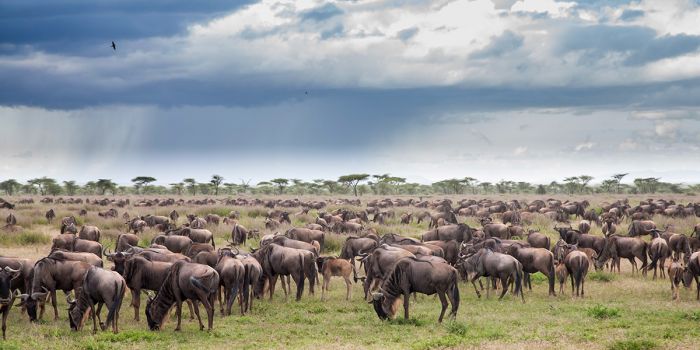
The wildebeest migration in the Seronera area.
Besides for the perennial Mbalageti and Orangi rivers (both of which are small streams really and only flow in the rainy seasons), there is very little permanent water in Seronera. Lake Magadi, a small saline pond of water fed by the Mbalageti river, supports superb bird life when water levels are sufficient, including flamingos in the many hundreds. Patches of Acacia woodland are interspersed with grasslands in Seronera and sparse riparian woods grow along the river courses.
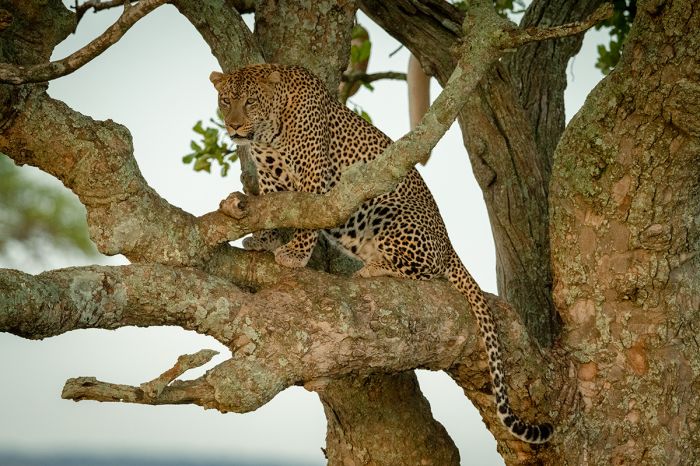
Male leopard in the Seronera area of the Serengeti.
The Serengeti's Park Headquarters are located in Seronera and the Seronera Visitor Centre offers permanent displays and exhibits, a shop, video screenings, and information on wildlife sightings and road conditions. The park's staff village is located here as well.
It is worth noting that because Seronera is the most accessible part of the park and also has a high density of safari lodges and camping sites, it is usually the busiest sector in terms of vehicles and tourist numbers.
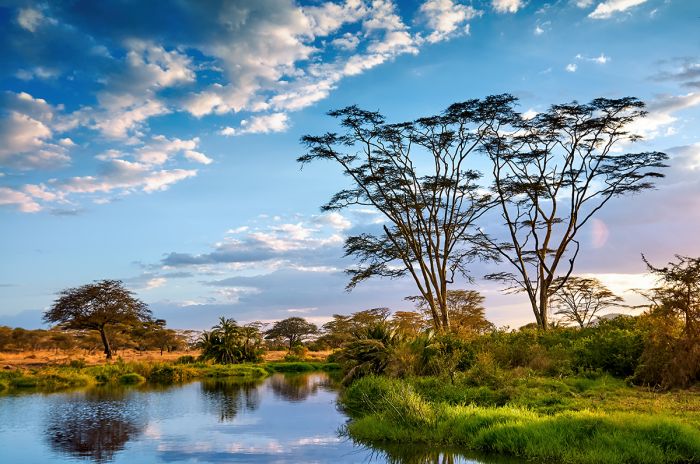
River scene in the Serengeti's Seronera sector.
Western Corridor: The strip of land extending westward from Seronera and continuing to within 5 miles (8 kms) of Lake Victoria is termed the Western Corridor. The Grumeti River is the key feature here, with forests and swamps lying to the north of the river and hilly grasslands to the south. This arm of land is much more densely vegetated than most of the park. The Mbalageti River also traverses the sector as it flows parallel to the Grumeti on its way to Lake Victoria.
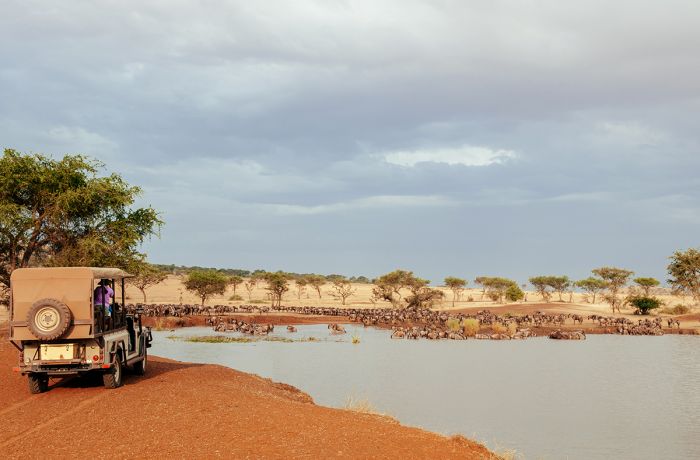
Wildebeests at the Grumeti River, Western Serengeti.
The annual wildebeest and zebra migration typically arrive around May and remain in the corridor through July, before continuing north towards the Kenya border and eventually into the Masai Mara. Migratory crossings of the Grumeti River, usually occurring in June-July, are treacherous if the river is flowing, with hungry crocodiles that have waited up to nine months for the arrival of the herds.
Resident wildlife is good all year in the corridor, with giraffe, buffalo, topi, hartebeest, eland, impala, Thomson's gazelle, waterbuck, and non-migratory wildebeests and zebras. Predator sightings are good year-round, with an abundance of lions and leopards and even some cheetahs in the grassland area. Birding in the forests is superb and there is a population of black-and-white colobus monkeys as well.
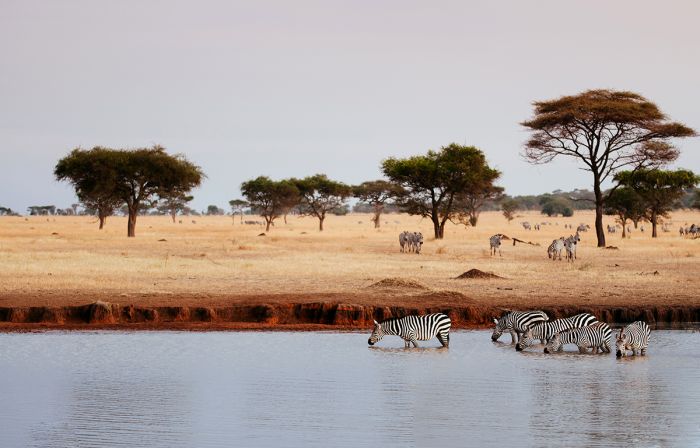
Zebras drinking at a Serengeti waterhole.
Northern Serengeti: The Acacia thickets that are present in Seronera are more prevalent as you move north into the hilly Northern sector, which comprises about one-third of the park and extends all the way to the Kenya border.
Dense Acacia woodlands are interrupted by rolling grasslands and riparian forests along the Grumeti and Mara rivers and their tributaries. While game viewing is not as spectacular as the more "classic" and open areas further south in Seronera and the Southern Plains, there is still good resident wildlife. Most of the Serengeti's elephants are found in the north, and there are also good resident numbers of zebra, buffalo, warthog, and gazelle.
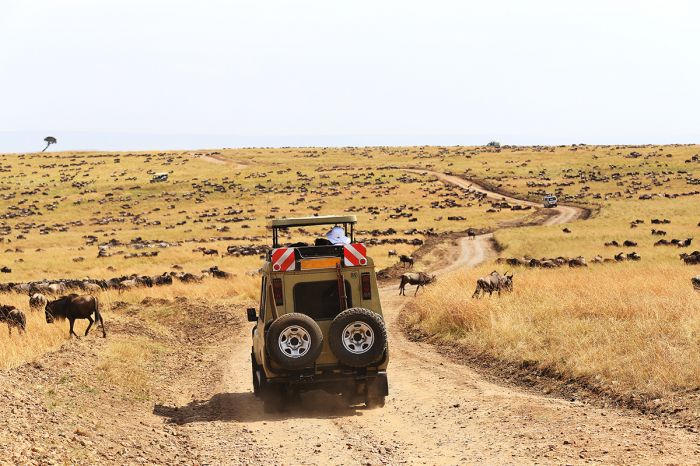
Game drive to see the wildebeest migration, Northern Serengeti.
The Lobo area is excellent during late September and October, when the wildebeest and zebra migration passes through on its way back south from Kenya, heading towards the southern plains. Lobo Kopjes, a group of huge granite boulders is a favorite hangout for large prides of lions and also draws leopards, spotted hyenas, and even cheetahs.
Most of the safari camps are situated along or very near to the Mara River, which becomes the focal point of action when the wildebeest migration arrives sometime around August. The drama unfolds when the herds congregate and eventually cross en masse with plenty of huge crocodiles in wait.

Wildebeests crossing a low water section of the Mara River, Northern Serengeti.
Lamai Wedge: One area that has exceptionally good wildlife is the Lamai Wedge, a triangular-shaped area north of the Mara River and south of the Kenya border. It is contiguous with the "Mara Triangle" on the Kenya side of the border and is home to good numbers of eland, buffalo, gazelle, wildebeest, zebra, and topi. When the migration moves through from late July through September, it is nothing short of spectacular. Crossings of the Mara River by massive herds of wildebeest and zebra with crocodiles doing their best to capture prey are a dramatic sight to see.
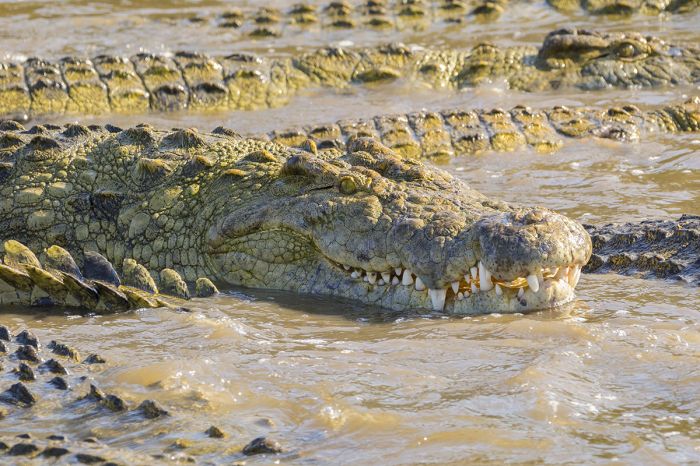
Nile crocodiles lying in wait in the Mara River.
Wildlife
It is of course obvious that the Serengeti's wildlife is the main attraction for tourists. The sheer numbers are staggering and no other region in Africa can come close in terms of total biomass. Resident wildlife numbers essentially double when the migrating herds of wildebeest and zebra arrive to an area.
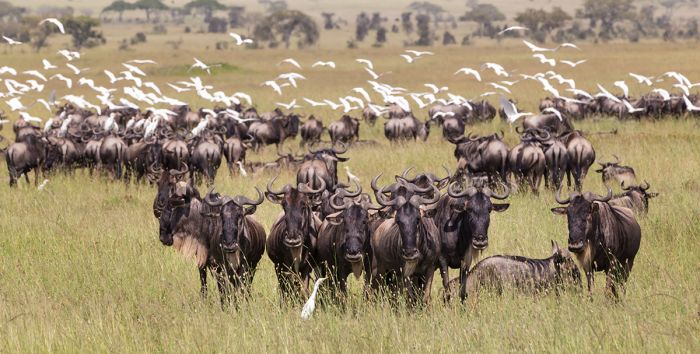
Blue wildebeest are the most numerous large mammal in the Serengeti.
The blue wildebeest is the most numerous large mammal occurring in the Serengeti/Mara ecosystem, with estimates ranging between 1.3 and 2 million individuals. Other abundant large mammals include Burchell's zebra (200 000 to 300 000) and Thomson's gazelle (400 000 to 500 000). Other plains game species with substantial populations include African buffalo, Masai giraffe, topi, eland, reedbuck, impala, bushbuck, Kirk's dik-dik, and warthog.
Elephants are relatively scarce on open grasslands, but are commonly encountered in the north and west, where there are more trees. Estimates of elephant numbers vary between two and five thousand in the Serengeti/Mara.
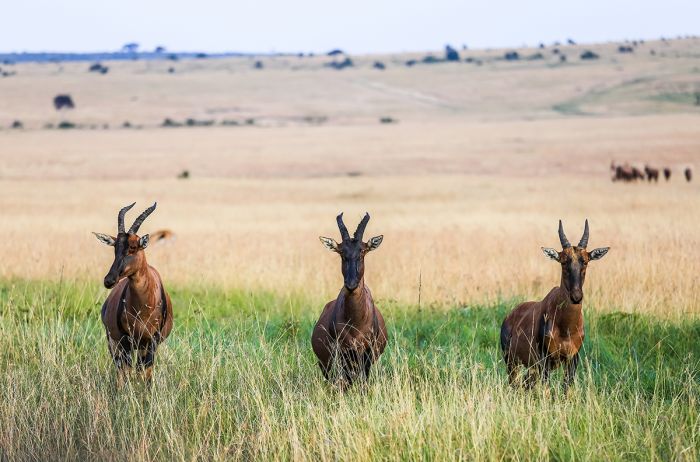
Topi antelopes in the Serengeti.
The most common large predator is the spotted hyena, who are often seen in very large clans numbering up to 80 individuals and whose numbers are estimated at five to eight thousand in the Serengeti/Mara. The abundance of prey in the Serengeti, combined with the large number of lions, which compete for the food, is the reason the clan sizes are sometimes so large here.
Lions are the most numerous big cat, with estimates of one to three thousand animals spread throughout the Serengeti/Mara. Large lion prides are common, especially in the plains areas of Seronera and the south. Other common predators include cheetah, leopard, serval, two species of jackal (side-striped and golden), and bat-eared fox.
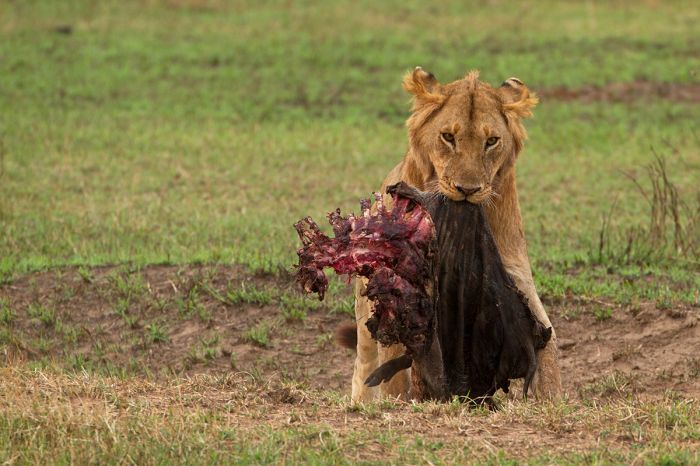
A lion carries a wildebeest kill in the Serengeti National Park, Tanzania.
The Serengeti is arguably the best place in Africa (along with the Masai Mara in Kenya) to see cheetahs. These beautiful cats are especially abundant in the open plains of Seronera and to the south around Ndutu. African wild dogs are hit and miss, as they are have very large ranges, which brings them into contact with domestic dogs outside the park the pass diseases like canine distemper or rabies.
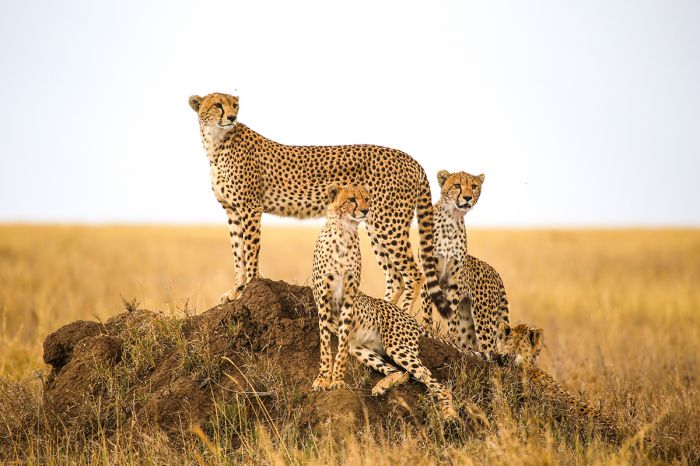
The Serengeti is the best place in Africa to see cheetahs.
Primates are limited to olive baboons and vervet monkeys throughout most of the Serengeti/Mara. A population of black-and-white colobus monkeys live in the riparian forests in the Western Corridor along the Grumeti River.
Bird life is abundant and varied, with over 500 species recorded. There are six species of vulture, over 30 species of raptor, and hundreds of species of smaller birds like woodpeckers, barbets, storks, and waterbirds. Keen birders can expect to easily tick 150 species in a day.
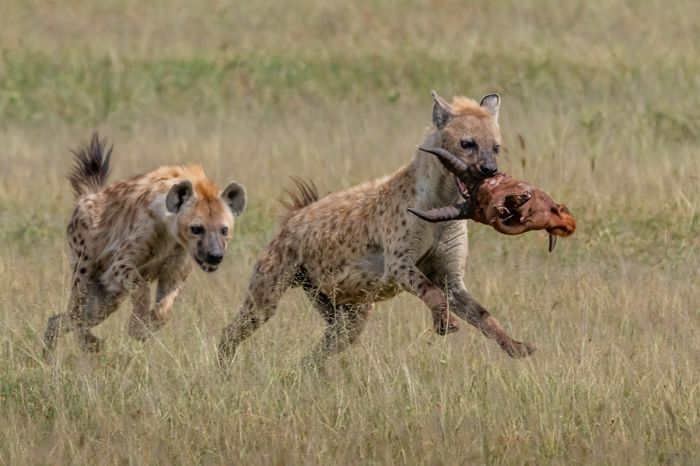
Spotted hyenas with the remains of a topi antelope in the Serengeti.
Accommodation
There is a wide array of accommodation in and around the Serengeti, ranging from ultra-luxurious lodges, high-end tented camps, more basic bush camps (with bucket showers), and some self-catering camping sites, including sites around Seronera, Lobo, and Ndabaka Gate.
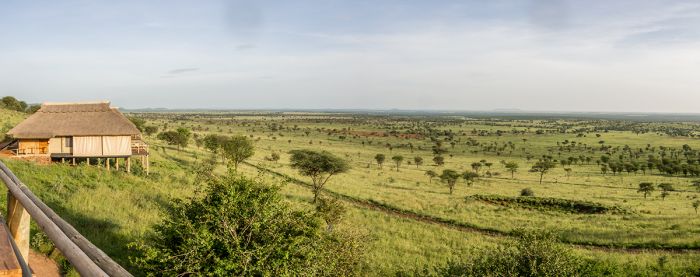
Sunrise from Kubu Kubu Camp in the Central Serengeti.
Another popular category of camp in the Serengeti is the 'Seasonal' or 'Migration' Camp. These camps are temporarily set up for two to four months at one of several locations to best allow guests to experience the ever-moving wildebeest migration. When the migrating herds move on from the location as part of their migratory cycle, the seasonal camp is taken down and moved to the next location, so that it is always located in the best spot to see the abundant herds.
Balloon Safaris
Several operators offer early morning hot-air balloon safaris over the plains. The prices start at USD 500 for an hour-long flight. The baskets fit 8-16 people, depending on the balloon size. The dry months of June thru October are the best months, as the rainy months can cause cancellations for wind and rain. Depending on the season, balloon safaris depart from Central Serengeti/Seronera (year round), Ndutu Area (late Dec thru March), Western Serengeti (June thru October), and Northern Serengeti (July thru mid-November).
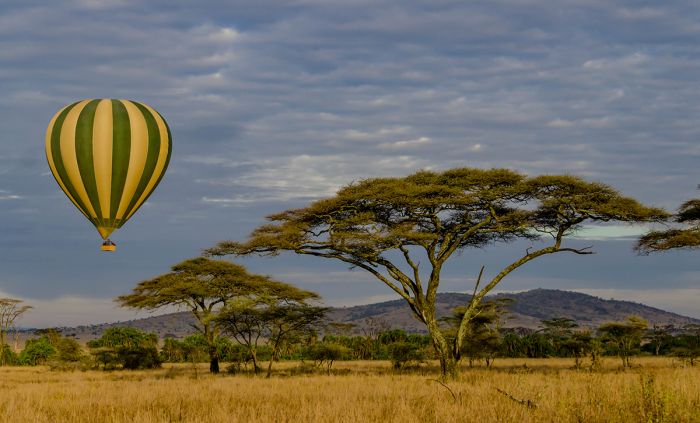
Sunrise balloon safari over the Serengeti.
Grumeti Game Reserve
An adjunct to the Western Corridor, the 550-square-mile (1400-sq-km) Grumeti Game Reserve was created in 1994 to conserve crucial habitat utilized by native wildlife and the annual migration of wildebeests and zebras. The reserve is managed by Singita, a high-end and well established safari operator in both East and Southern Africa. Several small lodges have exclusive access to the reserve. Wildlife is good all year, especially in along the rivers, but the best time to visit is from June thru Agust, when the migrating herds pass through, heading north towards Kenya.
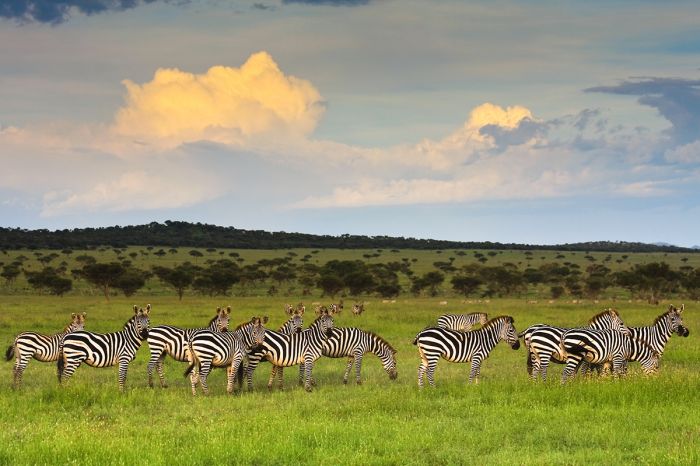
Zebras in the Grumeti Game Reserve.
Loliondo Game Controlled Area
Bordering the Serengeti National Park on the east is the 1 500-square-mile (4 000-sq-km) Loliondo Game Controlled Area. When the Serengeti was declared a national park, the indigenous Maasai people living within the park were forcible resettled outside the park, many into what is today Loliondo.
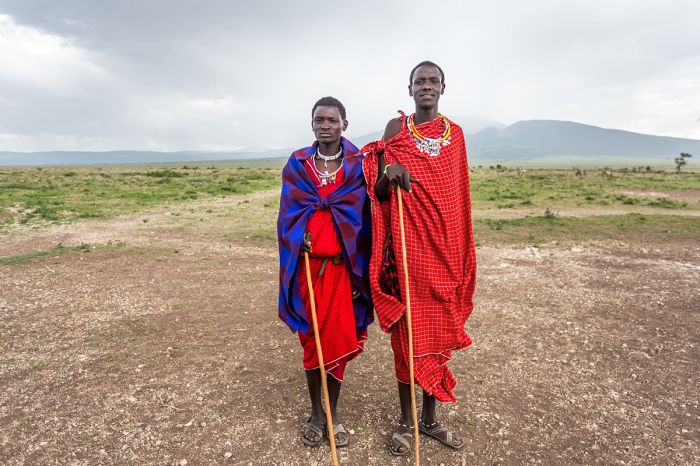
The Loliondo GCA is home to the Maasai people.
Tourism versus trophy hunting versus subsistence for the Maasai people is an ongoing struggle in Loliondo and continues today. The region of course has incredibly good potential for tourism, especially when the wildebeest migration passes through in November and December on its way south from the Masai Mara.
Our hope is that tourism and the Maasai will eventually co-exist together in such a way that the local people will benefit from safari camps in the future, but for now, this is uncertain.
Maswa Game Reserves
Bordering the Serengeti on the southwest, Maswa is another area that has allowed trophy hunting in the recent past. Maswa consists of three separate but contiguous reserves (south to north: Maswa Kimali, Maswa Mbono, and Maswa North) that have been reassigned from strictly hunting concessions to "multi-use areas", which means there is now some tourism opening up in the area. Hopefully the move towards tourism and away from hunting will continue.
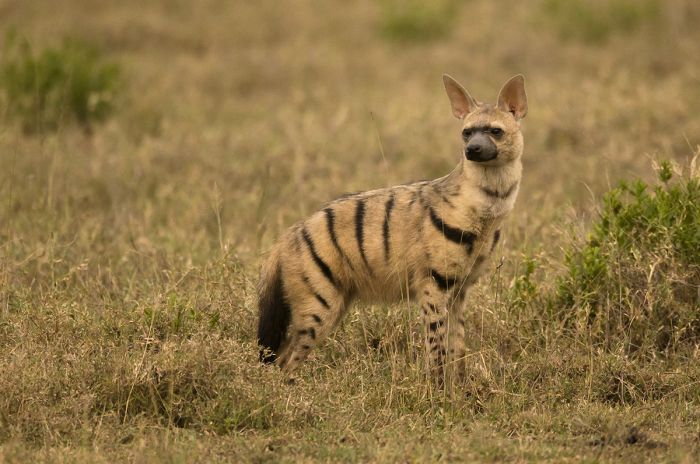
An aardwolf near Gol Kopjes, southern Serengeti.
Wildlife in the Maswa Reserves is very good, particularly when the Great Migration is in the southern plains of the Serengeti (January thru April). All of the Serengeti's plains game is also present in Maswa, including giraffe, topi, hartebeest, Thomson's gazelle, Grant's gazelle, and many more. Predators include lion, leopard, spotted hyena, and cheetah.
Ikona Wildlife Management Area
Established in 2007, the 94-sq-mile (243-sq-km) Ikona WMA borders the Serengeti and Grumeti. Ikona is a community-based wildlife area that leases its land to the Grumeti Fund, which operates eco-tourism safari camps in Ikona. Wildlife is abundant as expected and the migration passes through between May and June. Guests staying in the Grumeti Reserve are also permitted to visit Ikona.
Fort Ikoma is a historical colonial-era structure built by the Germans in 1905 as an administrative center and garrison to defend against raids by local tribes. During World War I, the fort was used by the Germans as a heliograph station. Today it is a tourist attraction, with bunkers and trenches still viewable by visitors.
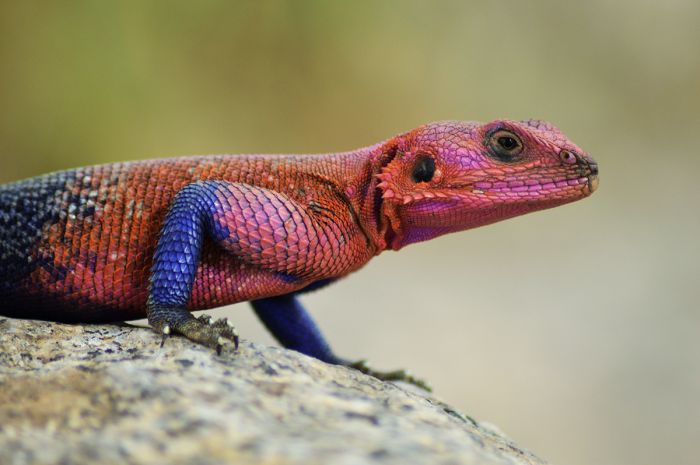
The Mwanza flat-headed rock agama is a common lizard in the Serengeti.
Ikorongo Game Reserve
Established in 1994 as a government-controlled buffer zone for the Serengeti, the 232-sq-mile (602-sq-km) Ikorongo Game Reserve is rich in wildlife, particularly when the migration passes through between May and July. Ikorongo is a mixed-use area, where hunting is technically permitted, but the reserve is functionally an eco-tourism destination.
The Grumeti River and numerous tributaries make Ikorongo a magnet for wildlife and the reserve is used on game drives for guests staying in the Grumeti Game Reserve.
Kijereshi Game Reserve
Located at the far south-western end of the Serengeti's Western Corridor, the Kijereshi Game Reserve covers a mere 25 square miles (66 sq kms). The reserve was established in 1994, along with several others bordering the national park, serving as a buffer zone against nearby human settlements.
The reserve's landscape is predominantly wooded grassland with additional amounts of open grassland and riparian forest.
Kijereshi is home to abundant wildlife and becomes a very good place for game viewing when the wildebeests and zebras in the Great Migration pass through the reserve between May and July, headed north to the Grumeti Reserve and onwards towards Kenya's Masai Mara. The reserve is designated as an eco-tourism reserve and hunting is not permitted.
Read More...
Accommodation, Balloon Safaris, Grumeti, History, Ikona, Ikorongo, Kopjes, Lamai Wedge, Loliondo, Maswa, Ndutu, Northern Serengeti, Serengeti National Park, Seronera, Southern Plains, Western Corridor, Wildlife
Great Good Fair Poor
- Jan
- Feb
- Mar
- Apr
- May
- Jun
- Jul
- Aug
- Sep
- Oct
- Nov
- Dec
Seasons and Rain
The Serengeti and Northern Tanzania are located very close to the equator and as such, temperatures are relatively static year-round and mainly influenced by altitude. Rain is the major determinant of wildlife movements and tourist numbers.
The Serengeti is a vast ecosystem, so choosing a particular sector (or sectors) within the national park or adjoining reserve is also important. The decision as to where to stay depends on what your focus may be (less crowds, see the migration, avoid any rain, etc).
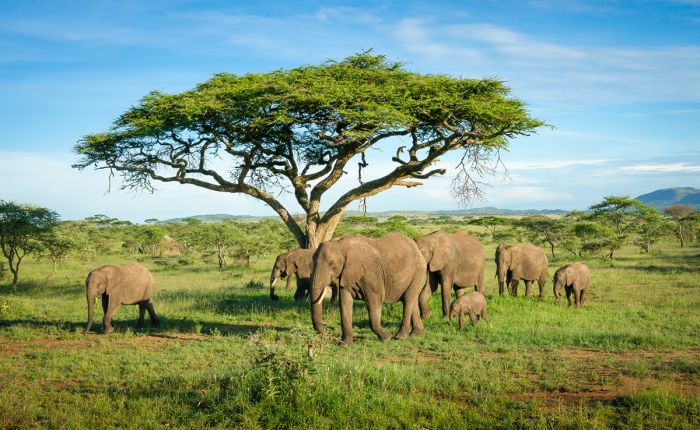
Elephants after some recent rain in the Serengeti National Park.
Rainfall generally occurs only between November and May, with two distinct rain seasons. The "Long Rains" in April/May (called the "masika") generally come as daily afternoon downpours, while the "Short Rains" occur from mid-November to mid-December (called the "mvuli") and come as lighter and less frequent showers.
In terms of visiting the Serengeti, the short rains are unlikely to interfere with daily activities and can even enhance the safari experience, with beautiful green color, dramatic skies, and plenty of migrant birds. The heavier long rains can sometimes become problematic, with roads becoming very muddy and the storms dumping large amounts almost daily.
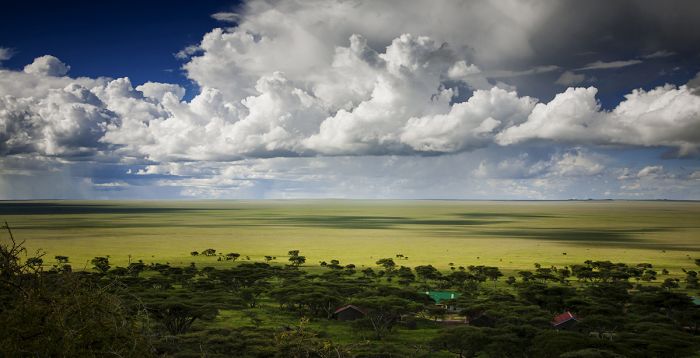
Fresh grass after early rains on the Serengeti's plains.
The Migration
The Serengeti's main tourist draw is undoubtedly the annual migration of some 1.5 to 2 million wildebeests, and several hundred thousand zebras that spend roughly nine months per year inside the national park and surrounding areas.
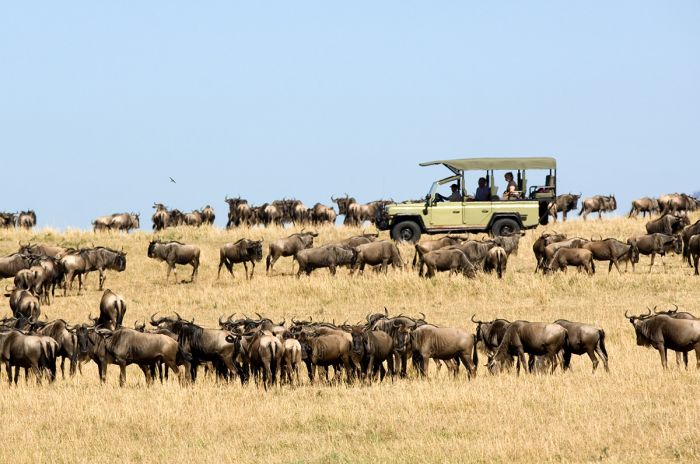
The Great Migration in the Serengeti.
The largest mammalian migration on earth, the animals follow a 500-mile (800-km) clockwise route through the Serengeti, Ngorongoro, and Masai Mara in search of the most nutritious grasses. If we assume the migration begins when a wildebeest calf is born, then this is between January and early March each year in the Southern Plains of the Serengeti, when roughly 500 000 baby wildebeests are born.
The herds remain in the south until late March when they slowly move north and west, reaching Grumeti and the Western Corridor in June and July. The herds cross into Kenya's Masai Mara around late August, where they spend three months before heading back south into Tanzania in late October or early November.
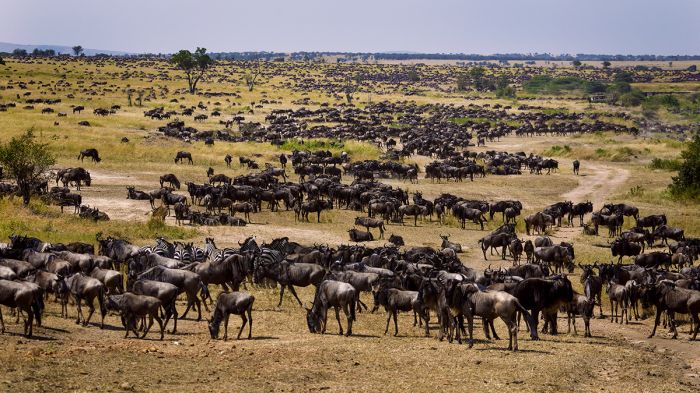
The migration of wildebeests and zebras, Serengeti National Park.
The migration is rarely ever the same in terms of precise timing and direction, as local rains and other conditions influence grass growth. The wildebeest may, therefore, move off the open plains earlier in some years and remain in the northern area for longer in others. Nonetheless, the best months for seeing the migration in the Serengeti are in February and March, when the herds are adding new babies, May and June, when the herds are the most concentrated, and in the far northern section from June thru August.
Many visitors are keen to witness the dramatic river crossings, with hungry crocodiles attacking the herds as they swim the dangerous rivers of the northern Serengeti. Like the migration in general, the precise timing of the river crossings is never known from year to year, but crossings on the Grumeti River are usually best in June, while Mara River crossings are best in July/August.
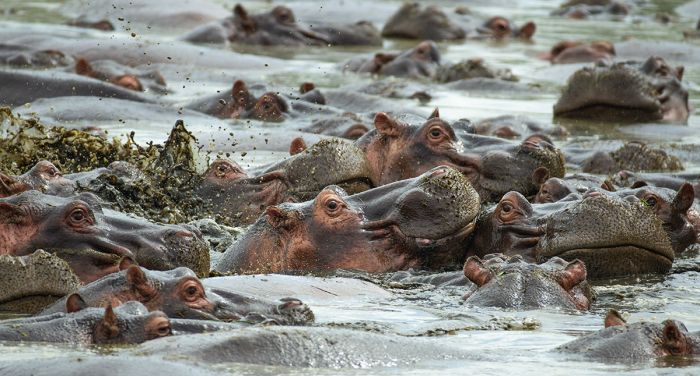
Hippos are common in the major rivers of the Serengeti National Park.
Temperature
November to March are the warmest days, averaging a low of 66 to 68°F (18 to 20°C) and highs of ~86°F (~30°C). May through August are slightly cooler months, where days start out at 57 to 61°F (14 to 16°C) and reach a noonday high of about 79°F (26°C).
Showing 1–14 of 14 results
A classic East African safari camp situated between the Southern Serengeti and Seronera. Offers excellent year-round game viewing, easy access to the Moru Kopjes, Lake Magadi, and the annual migration. …
Upscale lodge located in the remote Western Corridor of the Serengeti, which has fewer visitors and vehicles than most of the park. Well positioned along the route of the Great Migration of more than two million herbivores.…
Located in a large private land concession with no other camps or lodges, so very exclusive safari experience. Located along the route of the Great Migration traversed annually by more than two million herbivores. Hilltop site with incredible views.…
Located in the remote and uncrowded eastern Serengeti, with excellent year-round wildlife viewing and in the path of the Great Migration. The area is especially good for big cats, particularly cheetah.…
A classic, mobile tented camp that moves its location between the northern and southern Serengeti to stay close to the migrating herds of wildebeests and zebras. An authentic safari experience with creature comforts and superb wildlife viewing.…
Located close to the Mara River in the Northern Serengeti. Quick access to the river for viewing dramatic crossings during the migration. Excellent year-round wildlife. Game drives, walking, cultural experiences.…
Located in the path of the Great Migration, but in a secluded location to the south of the much busier Mara River / Kogatende area. Close enough to the river for day trips for those wanting to view crossings. Abundant year-round wildlife.…
Located in the central (Seronera) section of the park with twice yearly movements of the migration passing through. Day-trips to the wildebeest breeding grounds. Visits to Moru Kopjes and Lake Magadi.…
A tented camp that moves its location to stay as close as possible to the bulk of the herds in the Great Migration as it moves across the Serengeti. Luxurious tents, excellent service, great guiding and wildlife viewing.…
Singita Faru Faru Lodge is located in the greater Serengeti ecosystem in northern Tanzania. The lodge is ideally positioned on the Great Migration route traversed annually by more than two million herbivores.…
Singita Mara River Tented Camp is located in the Lamai Wedge portion of Serengeti National Park in northern Tanzania. The camp is ideally located on the bank of the Mara River and along the Great Migration route traversed annually by more than two million herbivores.…
Singita Sabora Tented Camp is located in the greater Serengeti ecosystem in northern Tanzania. The lodge is ideally positioned on the Great Migration route traversed annually by more than two million herbivores.…
Singita Sasakwa Lodge is located in the greater Serengeti ecosystem in northern Tanzania. The lodge is ideally positioned on the Great Migration route traversed annually by more than two million herbivores.…






